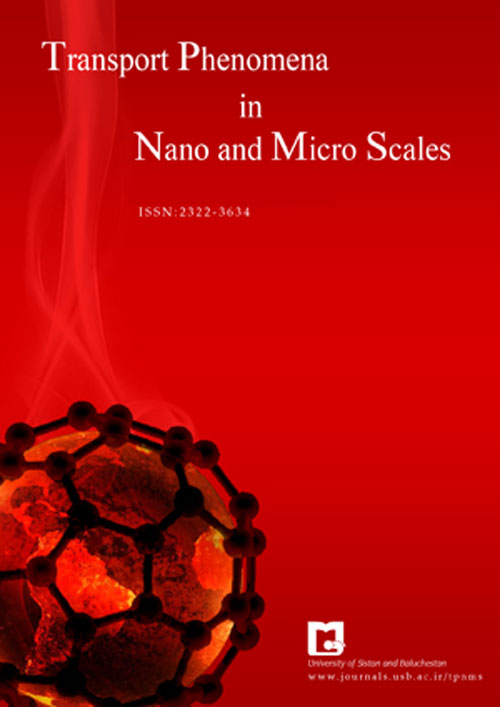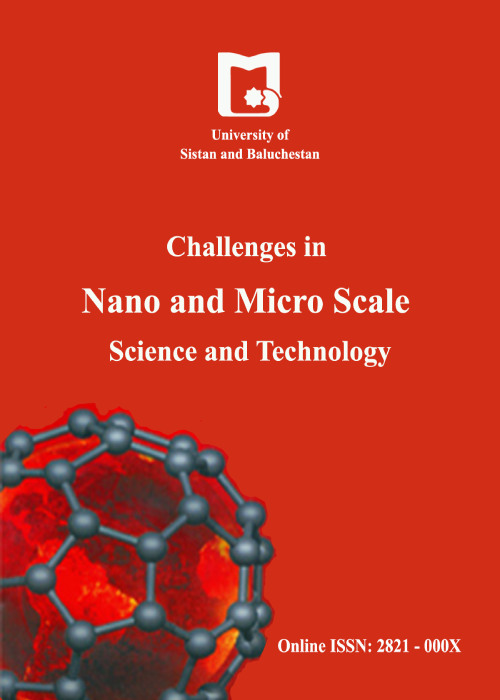فهرست مطالب

Journal of Transport Phenomena in Nano and Micro Scales
Volume:3 Issue: 2, Summer - Autumn 2015
- تاریخ انتشار: 1394/04/13
- تعداد عناوین: 7
-
-
Pages 68-76Micromixers are one of the most crucial components of Lab-On-a-Chip devices with the intention of mixing and dispersion of reagents like small molecules and particles. The challenge facing micromixers is typically insufficient mixing efficiency in basic designs, which results in longer microchannels. Therefore, it is desirable to increase mixing efficiency, in order to decrease mixing length, which enables miniaturization of Lab-On-Chip devices. This study investigates two different designs of a passive T-shaped micromixer employing several rectangular obstacles and grooves to monitor mixing efficiency with geometry change, while keeping the Reynolds number under 2. The mixing performance of these geometries is studied by numerical study and it was implemented in COMSOL Multiphysics environment. It was clarified that T-shaped micromixer with obstacles and grooved micromixer improved mixing efficiency of the basic design by 37.2% and 43.8%, respectively. Also, it was shown that this increase in mixing efficiency was due to the development of transversal component of flow caused by the obstacles and grooves.Keywords: Obstacle, Grooved, Micromixers, T, shaped, Mixing Efficiency
-
Pages 77-88The main purpose of this study is to perform numerical simulation of nanofluids as the coolant in VVER-440 fuel rod bundle. The fuel rod bundle contains 60 fuel rods with length of 960 mm and 4 spacer grids. In VVER-440 fuel rod bundle the coolant fluid (water) is in high pressure and temperature condition. In the present Thermo-hydraulic simulation, water-AL2O3 nanofluids containing various volume fractions of AL2O3 nanoparticles are investigated. Calculations performed for Reynolds number of 125000 to 203000, nanoparticles fraction of 0 to 0.05 and nanoparticles diameter of 20 to 100 nm. In this literature, the effects of diameter and volume fraction of nanoparticles on thermo-hydraulic parameters are studied. To perform correct calculation, different grid qualities of fuel rod bundle are studied and results are compared with reference results. Empirical studies show that as the temperature rises, the effect of nanoparticles on enhancing thermal conductivity intensifies. So it can be said that as the VVER-440 fuel rod bundle works in high temperature condition, using the nanofluids in this rod bundle can be effective. Results of our numerical study showed that by using nanofluids as coolant fluid the heat transfer coefficient increases significantly and heat transfer enhancement raises with increase in volume fraction of nanoparticle.Keywords: nanofluid, heat transfer coefficient, rod bundle, volume fraction, particle diameter
-
Pages 89-99In this paper, experimentally derived correlations of heat transfer and pressure drop are used in a Pareto based Multi-Objective Optimization (MOO) approach to find the best possible combinations of heat transfer and pressure drop of TiO2-water nanofluid flow in tubes fitted with multiple twisted tape inserts in different arrangement. In this study there are four independent design variables: the number and arrangement of twisted tape inserts (N), TiO2 volume fraction (φ), Reynolds number (Re) and Prandtl number (Pr). Seven twisted tape arrangement in three different categories are investigated. The objectives are maximizing the non-dimensional heat transfer coefficient (Nu) and minimizing the non-dimensional pressure drop (f Re). It is shown that some interesting and important relationships as useful optimal design principles involved in the thermal performance of nanofluid flow in tubes fitted with multiple twisted tape inserts in different arrangement can be discovered by Pareto based multi-objective optimization approach.Keywords: TiO2, water nanofluid, dual, triple, quadruple twisted tapes, multi, objective optimization, NSGA II, heat transfer enhancement
-
Pages 100-105The aluminum oxide materials are widely used in ceramics, refractories and abrasives due to their hardness, chemical inertness, high melting point, non-volatility and resistance to oxidation and corrosion. The paper describes work done on synthesis of α-alumina by using the simple, non-expensive solution combustion method using glycine as fuel.Aluminum oxide (Al2O3) nanoparticles were synthesized by aluminum nitrate 9-hydrate as precursor and glycine as fuel. The samples were characterized by high resolution transmission electron microscopy (HRTEM), field effect scanning electron microscopy (FESEM), X-ray diffraction (XRD) and electron dispersive spectroscopy (EDS). As there are many forms of transition aluminas produced during this process, x-ray diffraction (XRD) technique was used to identify α-alumina. The diameter of sphere-like as-prepared nanoparticles was about 10 nm as estimated by XRD technique and direct HRTEM observation. The surface morphological studies from SEM depicted the size of alumina decreases with increasing annealing temperature. Absorbance peak of UV-Vis spectrum showed the small bandgap energy of 2.65 ev and the bandgap energy increased with increasing annealing temperature because of reducing the size.Keywords: aluminum oxide nanoparticles, glycine, combustion, synthesis
-
Pages 106-117In this paper, Turbulent mixed convective heat transfer of water and Al2O3 nanofluid has been numerically studied in a horizontal tube under non-uniform heat flux on the upper wall and insulation in the lower wall using mixture model. For the discretization of governing equations, the second-order upstream difference scheme and finite volume method were used. The coupling of pressure and velocity was established by using SIMPLEC algorithm. The calculated results demonstrated that the convective heat transfer coefficient of nanofluid is higher than of the base fluid and by increasing the nanoparticles volume fraction, the convective heat transfer coefficient and shear stress on the wall increase. On the other hand, with increasing the Grashof number, the shear stress and convective heat transfer coefficient decrease.Keywords: Turbulent flow, mixed convection, nanoparticles volume fraction, horizontal tube, Grashof number
-
Pages 118-128In order to examine the laminar convective heat transfer of nanofluid, experiments carried out using silver-oil nanofluid in a concentric annulus with outer constant heat flux as boundary condition. Silver-oil nanofluid prepared by Electrical Explosion of Wire technique and observed no nanoparticles agglomeration during nanofluid preparation process and carried out experiments. The average size of particles established to 20 nm. Nanofluids with various particle weight fractions of 0.12%wt., 0.36%wt. and 0.72%wt. were employed. The nanofluid flowing between the tubes is heated by an electrical heating coil wrapped around it. The effects of different parameters such as flow Reynolds number, diameter ratio and nanofluid particle concentration on heat transfer coefficient are studied. Results show that, heat transfer coefficient and Nusselt number increased by using naanofluid instead of pure oil. Maximum enhancement of heat transfer coefficient occurs in 0.72% wt. also results indicate that heat transfer coefficient increase slightly by using low wt. concentration of nanofluids.Keywords: nanofluid, convective heat transfer, Nanoparticles, laminar flow
-
Pages 129-134That particles are of less than 100nm in diameter called nano particles (NPS) and there are in the world naturally like volcanic activity. In the present investigation a new mixed halomercurate nano particle compound was synthesised and characterized. Triphenylphosphonium trichloromercorate (II) [P(C6H5)3H]+[HgCl3]- nanoparticle was synthesi -zed by using triphenylphosphonium chloride reaction with HgCl2,in the presence of trimercaptopropionic acid. This method is a simple and direct method. The product was characterized by spectroscopic and analytical methods such as 31P-NMR, scanning electron microscopy (SEM), infrared spectroscopy (IR) and also size of nanoparticles were calculated by X-ray diffraction (XRD). Average particles size of nano is showed about 89.83 nm Theoretical calculations were applied for the structural optimization of this compound. The structure of compound has been calculated and optimized by the density functional theory (DFT) based method at B3LYP/6-311G levels of theory, using the Gaussian 09 package of programs. Finally, the comparison between theory and experiments are done.Keywords: Halomercurate, [P(C6H5)3H]+[HgCl3], Nanoparticles, synthesis, X-ray diffraction, SEM


